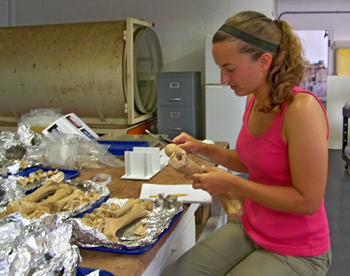Jenna Carlson Wins SAA Student Poster Award
 PhD student Jenna Carlson's poster presentation, Oxen at Oxon Hill Manor: Identifying Draught Cattle from the Archaeological Record of Colonial Maryland, has received the honor of top student poster at the 2015 Society of American Archaeology conference, recently held in San Francisco.
PhD student Jenna Carlson's poster presentation, Oxen at Oxon Hill Manor: Identifying Draught Cattle from the Archaeological Record of Colonial Maryland, has received the honor of top student poster at the 2015 Society of American Archaeology conference, recently held in San Francisco.
Jenna's poster was based on the analyses she did of cattle remains from eighteenth-century deposits at Oxon Hill Manor in Maryland. By looking at the lower leg bones of oxen for signs of work-related pathologies/modification and sexual dimorphism, she identified their work history from the archaeological record. Oxon Hill Manor, like many Chesapeake plantations, started out in the eighteenth-century as a tobacco plantation, but then switched to mixed grain production around the mid- to late-eighteenth century. With that switch in agriculture, one would expect to find more work-related pathologies in the later bone remains, due to increased plowing and cultivation using draft animals rather than the hand methods used in tobacco cultivation. What was also noticeable was that during the earlier part of the eighteenth century, cattle were generally older at death / butchering than those in the later eighteenth century. This is likely because with the switch to mixed grain production, efforts of the plantation were also put into livestock production and the management of pasture lands, meaning that the cattle likely did not take as long to reach a marketable weight, so did not reach the older ages seen in the earlier eighteenth century. Jenna's poster thus gives insight into the changing agricultural practices in the early Chesapeake, changes tied to larger-scale developments in the economic and social world of the colonists. Congrats, Jenna!














